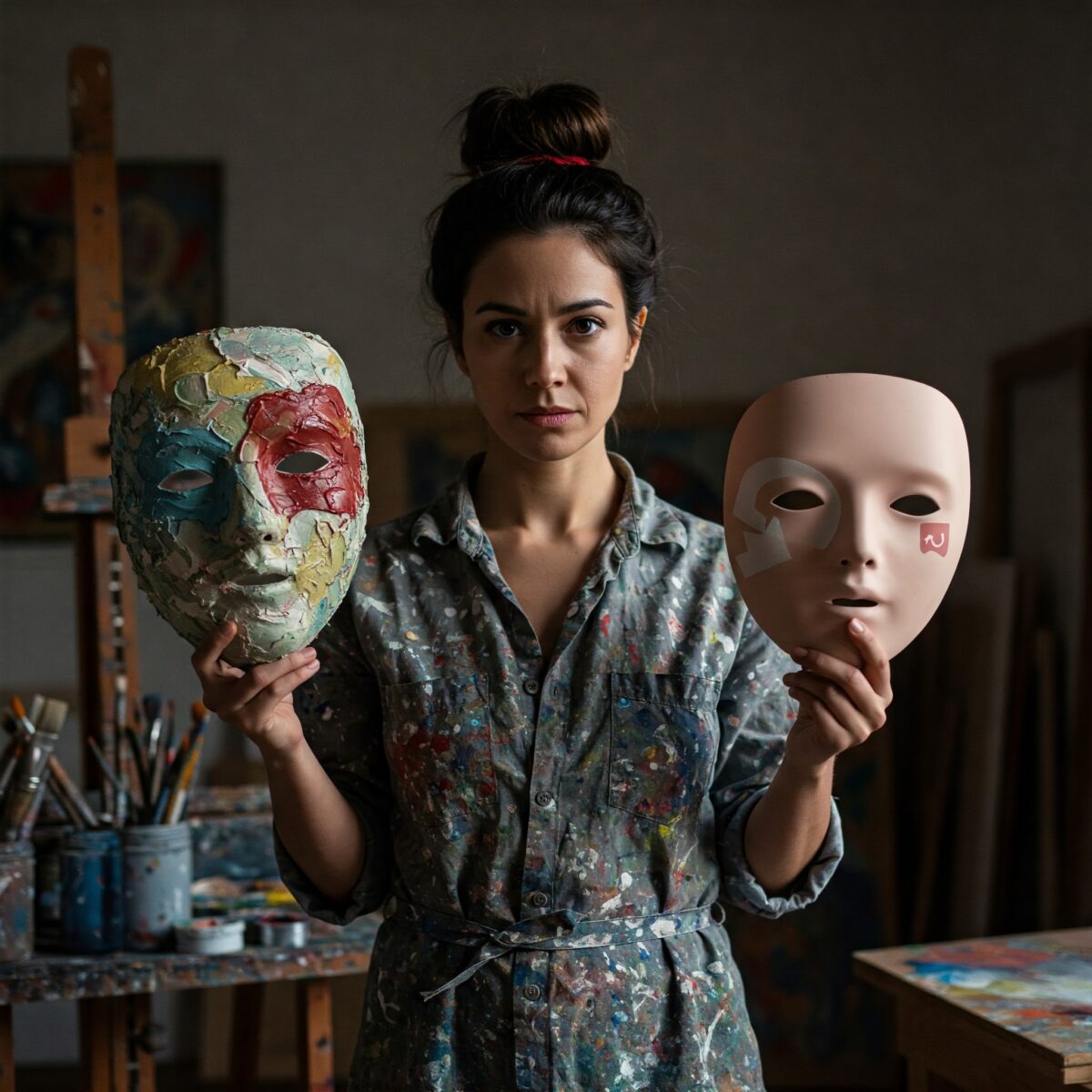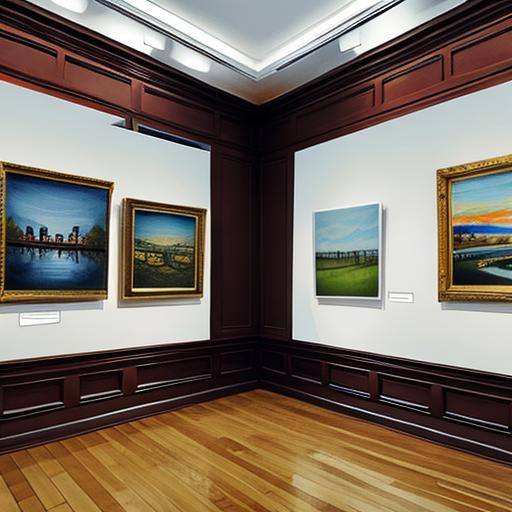Is that painting you just double-tapped on Instagram the next big thing? Or maybe you are the painter, wondering how to get your masterpiece seen beyond your studio walls. In today’s world, screens are everywhere, and social media influence on painters is a massive force, changing everything from how artists create and connect to how they sell their work and build their careers. It’s like a giant, bustling, digital art gallery mixed with a chatty café and a busy marketplace, open 24/7 to the whole world. But like any powerful tool, it comes with its own set of amazing opportunities and tricky challenges.
Key Points Summary:
- Global Stage: Social media gives painters unprecedented visibility, connecting them with audiences and buyers worldwide.
- Direct Connection: Artists can bypass traditional galleries to communicate directly with collectors and fans, building a personal brand.
- Community Hub: Platforms like Instagram and TikTok foster vibrant online art communities for support, feedback, and inspiration.
- Sales Channels: Social media acts as a powerful tool for direct sales and driving traffic to online shops.
- The Pressure Cooker: Algorithms, the hunt for likes, and comparison culture can negatively impact mental health and creative authenticity.
- Trend vs. Truth: Painters face the challenge of staying true to their artistic vision while navigating online trends for visibility.
- Strategic Use is Key: Success requires a mindful approach, focusing on genuine engagement, consistency, and setting healthy boundaries.
The Rise of the Digital Canvas: Understanding the Social Media Influence on Painters
Not long ago, getting your paintings seen usually meant hoping a gallery owner would notice you, or maybe getting into a local art show. It was tough to reach people outside your immediate area. Then came the internet, and boom! Social media platforms like Instagram, Pinterest, TikTok, and even Facebook changed the game entirely. Suddenly, painters could share pictures and videos of their work, their process, and their studio life with potentially millions of people instantly. This wasn’t just about showing off; it became a vital part of the artist online presence and a key strategy for digital marketing for artists.
Think about it: a painter in a small town can now have fans and art collectors following their work from big cities across the globe. This digitalization of the art world has torn down old barriers and created a whole new landscape for painter visibility online.
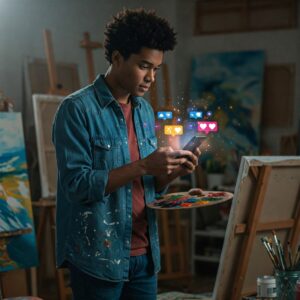
Unprecedented Exposure and Reach
The number one benefit? Getting seen! Social media is like handing artists a megaphone.
Platforms of Choice
- Instagram: Still the king for visual artists. Its focus on images and short videos (Reels) makes it perfect for showcasing finished paintings, process shots, and studio glimpses. Using relevant hashtags helps categorize work and reach interested viewers. Want to learn more about specific techniques you see? Check out guides like this beginner’s guide to famous artist styles.
- Pinterest: A visual discovery engine. Painters use it to share work, create inspiration boards, and drive traffic to their websites or online shops. It’s great for reaching people actively looking for art and aesthetics.
- TikTok: Increasingly popular, especially for showing the process. Time-lapses of paintings coming to life, quick tips, and behind-the-scenes fun connect with a younger audience and showcase the artist’s personality. Some trends even influence styles, like those seen in contemporary painting.
- Facebook: Still useful for building groups, sharing longer updates, and connecting with a broad audience, including local communities.
- Behance & ArtStation: More portfolio-focused platforms, often used by illustrators and digital artists, but traditional painters also use them to showcase professional bodies of work.
Direct Connection with Collectors
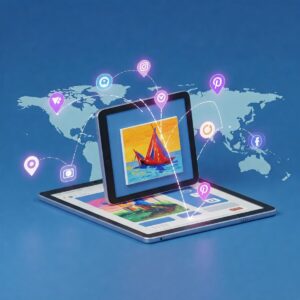
Forget waiting for a gallery opening. Social media lets painters talk directly to people interested in their art. They can answer questions, share the story behind a piece, and even handle sales themselves through DMs or links to online stores (like Etsy or Saatchi Art, or their own website). This direct line builds relationships and allows artists to control their artist brand and narrative. It’s a game-changer for selling art directly online. If you’re starting out, learning how to sell art online is crucial.
Building Community and Finding Inspiration
Social media isn’t just a broadcast tool; it’s a two-way street. Painters can find their tribe online.
- Peer Support: Connecting with other artists provides encouragement, feedback, and a sense of camaraderie that can be missing when working alone in a studio. Seeing others navigate challenges can be incredibly validating.
- Learning & Feedback: Artists share techniques, discuss materials (like the difference between primers and gesso), and offer constructive criticism. This online community becomes a virtual art school and support group rolled into one.
- Inspiration & Trends: Scrolling through feeds exposes painters to diverse styles, new art trends, and different approaches. Seeing what resonates with audiences can spark new ideas, though this comes with its own set of challenges (more on that below!). Discovering artists like Hockney or exploring movements can fuel creativity.
The Flip Side: Challenges and Pressures
While the benefits are huge, the social media influence on painters isn’t all rosy. There’s a darker side that artists constantly grapple with.
The Algorithm Game
Social media platforms use algorithms – complex computer programs – to decide who sees what. To get seen, artists often feel pressured to post frequently, use specific formats (like Reels), and chase engagement metrics (likes, shares, comments, saves). This can feel like a hamster wheel, taking time away from actually painting and potentially pushing artists towards creating content for the algorithm rather than from the heart. How social media algorithms affect painter visibility is a constant source of stress for many.
Comparison Culture and Mental Well-being
Imagine constantly seeing polished, perfect-looking art and seemingly successful artists every time you open an app. This creates intense comparison culture. It’s easy to feel inadequate, doubt your own progress, or tie your self-worth to likes and follower counts. The negative effects of social media on artists’ creativity and mental health are real. The pressure to be “always on,” constantly producing, and projecting success can lead to burnout and anxiety. Finding ways to protect your well-being is important, perhaps exploring art for well-being.
Authenticity vs. Trend-Chasing
Seeing certain styles or subjects get lots of attention (viral art) can tempt painters to jump on the bandwagon, even if it doesn’t align with their true artistic voice. Balancing authenticity and trends on social media as a painter is a tightrope walk. Do you paint what’s popular to gain visibility, or stick to your unique vision even if it gets less immediate attention? This internal conflict can stifle genuine creativity. Sometimes, looking back at the masters like Monet can help ground an artist’s vision.
Strategies for Painters Navigating the Social Media Landscape
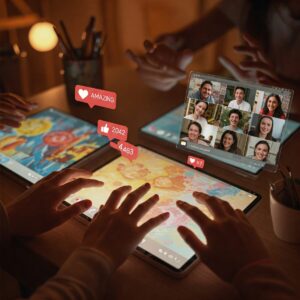
So, is social media necessary for painters to succeed today? While not strictly mandatory, it’s undeniably a powerful tool. The key is to use it strategically and mindfully. Here are some tips:
- Find Your Platform(s): You don’t need to be everywhere. Pick 1-2 platforms that suit your style and where your target audience hangs out. Learn how painters use Instagram to get noticed, for example.
- Be Authentic: Share your real process, struggles, and personality. People connect with genuine stories. Build your unique art brand.
- Consistency over Quantity: Find a posting schedule you can maintain without burning out. Quality content is better than constant noise.
- Engage Genuinely: Don’t just post and run. Respond to comments, follow other artists, and participate in the online art community.
- Show, Don’t Just Tell: Use high-quality photos and videos. Show your process, your studio, and close-ups of texture (like in impasto techniques).
- Use Hashtags Wisely: Research relevant hashtags to reach broader audiences interested in your specific style or subject.
- Set Boundaries: Don’t let social media consume your creative time or mental energy. Schedule specific times for it, turn off notifications, and remember that your worth isn’t tied to metrics.
- Focus on Connection: Use it as a tool to build relationships, not just chase followers.
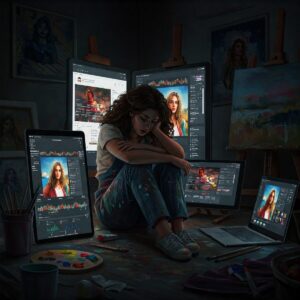
The Future is Phygital? Social Media and the Evolving Art World
Where is this all heading? The lines between the physical and digital art worlds continue to blur. We see:
- Hybrid Exhibitions: Galleries using social media to promote physical shows and offer virtual tours.
- Digital Art & NFTs: While controversial, the rise of digital art and Non-Fungible Tokens (NFTs) has been heavily fueled by social media communities. Even traditional painters are experimenting with digital mediums, perhaps learning how to make digital art look traditional.
- AI’s Role: Tools using artificial intelligence are emerging, both for creating art and analyzing it, adding another layer to the digital conversation. Understanding AI art ethics is becoming increasingly relevant.
Social media platforms will continue to evolve, and artists will need to adapt. The core challenge remains: leveraging these powerful tools without losing sight of the art itself.
“The internet hasn’t changed what art is, but it has dramatically changed where and how we experience it, connect with it, and support the artists who create it.”
Anonymous Art Critic

Conclusion: Painting Your Path in the Digital Age
There’s no denying the powerful social media influence on painters. It has democratized exposure, opened up global markets, and fostered vibrant communities in ways previously unimaginable. Emerging painters especially benefit from the ability to build an audience and sell original paintings directly. However, this digital canvas is also splattered with challenges: the pressure of algorithms, the sting of comparison, and the constant battle for authenticity. For painters today, navigating social media successfully means embracing the opportunities while fiercely protecting their creative spirit and mental well-being. It’s about using the tools strategically, not letting the tools use you.
Frequently Asked Questions (FAQ)
Q1: How has social media changed the art world?
Social media has dramatically changed the art world by increasing visibility for artists, allowing direct connection and sales between artists and collectors globally, creating online art communities, influencing art trends, and shifting some power away from traditional galleries.
Q2: What are the pros and cons of social media for artists?
- Pros: Global reach, direct sales, community building, networking, feedback, finding inspiration, building a personal brand.
- Cons: Pressure from algorithms, comparison culture, negative impact on mental health, trend-chasing potentially compromising authenticity, time commitment, dealing with negativity or plagiarism.
Q3: What are the best social media platforms for painters?
Instagram is generally considered the top platform due to its visual focus. Pinterest is great for discovery and inspiration. TikTok is rising for process videos and personality. Facebook can be good for community groups and broader reach. Behance is more portfolio-oriented. The “best” depends on the artist’s goals and style.
Q4: Do artists need social media?
While not strictly necessary (some artists succeed without it), social media is an incredibly powerful and common tool for visibility, networking, and sales in today’s art market. It’s highly advantageous, especially for emerging artists.
Q5: How do artists sell their art on social media?
Artists sell via DMs, linking to their online shop (Etsy, personal website, Saatchi Art, etc.) in their bio or posts, using shopping features on platforms like Instagram, announcing sales or commissions, and building relationships that lead to purchases. Check out tips for selling art online for beginners.
Q6: What are the mental health challenges for artists on social media?
Key challenges include anxiety from comparison culture, pressure to constantly create and post, tying self-worth to likes/followers, dealing with negative comments or criticism, burnout from the “always on” nature, and fear of missing out (FOMO).
Q7: How do artists get discovered on Instagram?
Discovery happens through consistent posting of high-quality work, using relevant hashtags, engaging with the community (commenting, liking, sharing), collaborating with others, being featured by larger art accounts, and sometimes, getting lucky with the algorithm or a viral post

